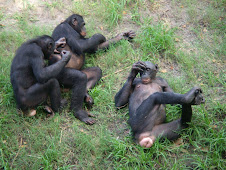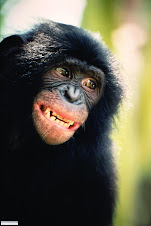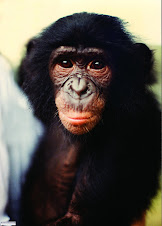 This little animal is a young Demodoffs galago, a primitive primate, photographed in the deep rainforest of the Equateur region in Zaire (now the Democratic of the Congo). Galagos, of a dozen species, are also known as bushbabies, due to their cries that sound like human babies.
This little animal is a young Demodoffs galago, a primitive primate, photographed in the deep rainforest of the Equateur region in Zaire (now the Democratic of the Congo). Galagos, of a dozen species, are also known as bushbabies, due to their cries that sound like human babies.With a 5 inch body and 7 inch tail, the tiny Demodoffs is one of the world's smallest primates. Its enormous eyes are adapted to see at night, where it forages for fruit, bark, tree gums, leaves, and bird eggs. Its independently mobile ears can catch the sound of insects, a favorite food.
In Africa, I mostly knew galagos from hearing them at night, and seeing the bright glint from their eye shine. Galago eyes have a reflecting surface called a tapetum, that is designed to capture light. During the day, the pupils become a vertical slit, like a cat's. They and have a moist nose that has a groove communicating with the brain's Jacobson's organ, which is specialized for the sense of smell.
Another unusual characteristic is the incisors that have grooves, like a comb, along with a similar structure at the front of the tongue. These two -- along with a long nail on the second toe of the foot, work together to clean the fur during self-grooming.
Demodofs galagos are social, and travel in groups of a dozen or more by climbing, hopping, and leaping in the deep forest in which they live. They build leaf-nests or bed down in leaf tangles for sleeping during the day. Galagos breed once a year and have one or two babies, that are carried by the mother for two weeks. After that, the babies become more independent, and are weaned in four months. They live ten years.
Photo by D. Messinger













No comments:
Post a Comment